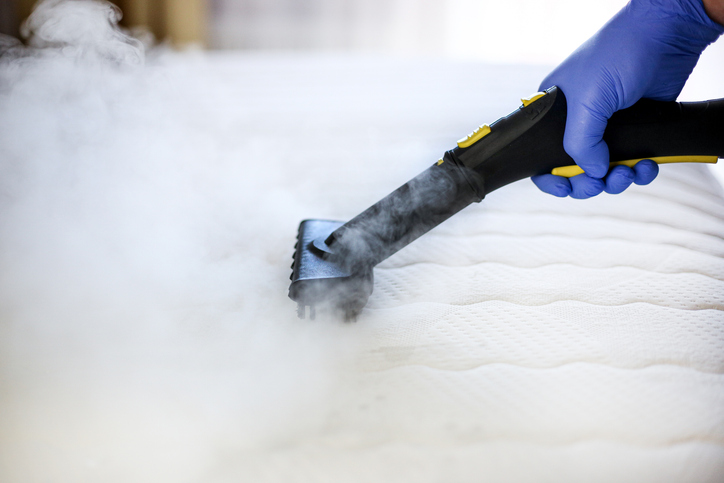Whether you want to stay prepared for overnight guests at your house or your new apartment has fewer bedrooms than your previous space, storing a mattress often becomes a necessity for homeowners and renters alike. Finding the space to keep your mattress out of the way comfortably, however, is another story.
Maintaining its shape and cleanliness helps you get the rest you need, but it can also mean putting off buying an expensive new mattress for a little longer. Here at Compass Self Storage, we’re fans of great sleep and quality storage. If you’re looking for the best way to store a mattress, take a look at our helpful mattress storage tips before you store yours.
What To Do Before Storing Your Mattress

Before storing your mattress, set yourself up for success by thoroughly cleaning it. The better condition your mattress is in when it goes into storage, the less likely you are to find unpleasant surprises like mold and mildew.
Start cleaning your mattress by taking off the bedding, including pillows, the comforter, and sheets. Next, remove debris with a hand-held vacuum cleaner. We recommend lightly steaming the mattress or applying an upholstery cleaner sparingly if you don’t have access to a steamer. The main goal is to clean the mattress without soaking it to prevent excess moisture from collecting.
Allow at least 24 hours of drying time before placing it in storage. Apply a thin layer of baking soda, allowing enough time for it to absorb before vacuuming the surface.
Once you’ve cleaned your mattress of stains, dirt, and grime, cover the mattress in plastic and tape the cover shut for maximum peace of mind. Mattress covers are designed to provide optimal storage conditions and may be available for sale at your local storage facility.
What Should I Do With My Extra Bedding While My Mattress Is in Storage?
To save even more space in your house or apartment while your mattress isn’t being used, we recommend keeping your bedding in storage, too. After you’ve cleaned your mattress, wash, dry, and fold your bedding, and put them in an airtight container. If you have enough space, you can keep the packed bedding with your mattress wherever it goes.
How Do You Store a Mattress?
When storing your mattress, there are two things you’ll want to keep in mind: avoiding moisture and maintaining the shape of your mattress. To achieve both, the best way to store your mattress without potentially harming it is to place it in a climate-controlled storage unit. These units are kept at a consistent temperature range all year, and offer the best peace of mind for your mattress.
If you live in a house, you may be tempted to keep your mattress in your garage, attic, or basement, but storing a mattress in any of these spaces increases your risk of mold or mildew growing or summer heat damaging it. Considering that the average cost of a queen-size mattress can range from $850 to $1,650, such a mistake can be costly.
In addition to shielding your mattress from extreme heat and cold and helping it stay dry, a climate-controlled storage unit gives you ample space for storing your mattress.
We rotate our mattresses for a reason: to prevent the repeated pressure of our bodies from creating a permanent, self-sized crater. To prevent damage to your mattress during storage, place it flat on top of items or on its own on pallets. This emulates how a mattress would normally be in your bedroom.
Additionally, avoid placing anything on top of your mattress when storing it, and ensure it isn’t stored bent, as this bend can become permanent. We also encourage you to air your mattress out every few months to keep it fresh and allow you to check for pests and mold in the process.
How To Store a Memory Foam Mattress
Climate-controlled storage is vital for memory foam mattresses. Memory foam is designed to soften in response to your body temperature and reform when you get up in the morning, but if it freezes in storage, it can crack, and excessive heat can deform it.
Keeping your memory foam mattress in a climate-controlled storage unit shields it from extreme heat or cold, which can ruin its ability to form comfortably to your body the next time you lie down on it.
When storing a memory foam mattress, keep it flat and shield it from moisture with a mattress bag or cover. You should also avoid storing anything on top of your memory foam mattress, especially heavy boxes or belongings.
Is It Bad To Store a Mattress Vertically?
Yes, it is bad to store a mattress vertically, no matter what kind it is. Whether you prefer a traditional innerspring mattress or one with memory foam, storing a mattress upright will stress its internal structure, often creating issues such as lumps, sagging, or dents that permanently impact how comfortable it is. For the same reason, you should not store a mattress on its side, either.
If you’re wondering how to store a mattress in a small space, remember that the most important factor is keeping the mattress lying horizontally. You shouldn’t use a storage space that requires your mattress to be stored vertically.
Can I Stack Multiple Mattresses for Storage?
Stacking multiple mattresses for storage is risky for several reasons. Similar to storing a mattress vertically or on its side, placing mattresses on top of each other can damage their internal structures by warping springs or compressing memory foam.
Storing mattresses in a stack can also void your warranty. Some mattress warranties may cover sagging, but compression is typically not considered part of the warranty.
Another issue with storing a mattress on top of another is trapping moisture between them. Any humidity caught under the mattress can transform into mildew over time, ruining both of the mattresses it comes in contact with.
If you need to store multiple mattresses, we recommend finding a space that helps you avoid stacking. Fortunately, you can find a wide range of storage unit sizes to accommodate the number of mattresses you need to store.
How To Transport Your Mattress Into Storage

So far, we’ve covered how to prepare your mattress for storage and how to tuck it away properly. But what does successfully moving into storage look like? You’ll want to get a durable but breathable mattress bag that won’t tear or rip while you’re moving your mattress. Next, check the size of your mattress against the size of the vehicle you’re using to move it.
If you have a large SUV, truck, or minivan, you should be able to transport a twin, full, or queen mattress. Keep the forecast in mind if you plan to transport your mattress in an open truck bed. The last thing you need is rain ruining it!
Whether you don’t own a large personal vehicle or your mattress won’t fit into your van, the best way to transport a mattress is to rent a moving truck. Like storage units, moving trucks come in a variety of sizes, from cargo vans to 26-foot trucks, to fit your needs.
Once you’ve landed on your mode of mattress transportation, we recommend clearing a path in your house or apartment so you can maneuver the mattress outside without bumping into furniture or tripping over shoes or toys that may be on the floor.
When you get your mattress to your vehicle, remember to lay it flat to prevent any warping while you transport it to your self storage unit.
Simplify Storing a Mattress With Compass Self Storage Today
Mattresses are a long-term investment. Most of us can go 10 to 15 years without replacing our mattresses, provided we take proper care of them. As a result, damaging it while it’s in storage can ruin years of usage.
Wherever you choose to safeguard your mattress and however long you’re putting your mattress in self storage, using these recommended techniques can help you care for your investment.
Compass Self Storage can provide the mattress storage you’re looking for. We offer clean, secure storage facilities with units in a wide range of sizes. Our friendly, knowledgeable staff can help you make the right choice. Find a Compass Self Storage facility near you and get started today!
